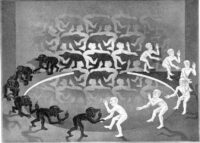The current spectacle of angry mobs fulminating against government by using degrading images and violent language to incite others has its echo in the past. Using the poor, disenfranchised and minorities as targets embedded in a protest against government is eerily familiar, harkening back to the 1920s and the National Socialist Party (Nazi) demonstrations in Germany. I wonder; if you or I used our Facebook pages to place cross-hairs on the faces of prominent political figures, as Sarah Palin has done, would we be arrested for making a threat to commit violence?
The world has seen this particular drama before, and it does not end well. Gun-toting reactionary forces of authoritarianism are once again asserting themselves in typically incendiary fashion, asserting false and inflammatory claims that mobilize the angry, scared and uninformed. In these difficult economic times, fear and anger are already plentiful. Though the seeming target is government, the actual target is America’s growing population of non-white, economically depressed, homosexual and non-citizen residents.
In 1920s Germany – society reeling from post-WWI inflation and the changes wrought by the increased democratic liberalism of the Weimar Republic – reactionary Nazi movements mobilized millions in support of identifying scapegoats to blame and punish. Jews, Gypsies, homosexuals and Bolsheviks were eventually targeted, but it is interesting to note that the first widespread implementation of Nazi cultural imperatives occurred within Germany’s health care system, through a eugenics program directed at the powerless.
Eugenics proposed that inferior racial, criminal, anti-social and hereditary medical problems could be selectively “bred” out of the human gene pool, resulting in a population of genetically pure people free from defect and therefore creating a better society. Eugenics elevated the “superior” white race above all others. Coincident with Germany’s fascist upheaval, eugenics also enjoyed widespread support in America. Oil tycoon John D. Rockefeller provided eugenics research with generous financial support, and the medical establishment in America and Germany were the beneficiaries of his largesse.
By 1930, the popularity of eugenics in the U.S. resulted in the institution of forced sterilization programs in nearly 30 American states, and tens of thousands of poor, black and variously handicapped Americans were involuntarily sterilized up until 1963. In Germany of 1933, recognized as having the world’s most modern health care, the Nazi government implemented forced sterilization of “the feeble, negroes, criminals, and the insane” after carefully observing the success and public acceptance of the sterilization program in America. Administered by doctors and nurses in both countries, eugenic sterilization was viewed as “cutting edge” health care for the future of an entire nation. In retrospect, of course, we can see that in Germany it provided a foundation for the genocide of those deemed by the Nazi’s as “parasites.”
Such inflammatory language is now popping up in our own current political sphere. The ultra-right-wing, with its ideological roots deeply set in America’s persistent racial intolerance, characterizes illegal immigrants and the ethnic poor as “parasitical,” feeding off the body of a host nation. Those of differing political persuasion are labeled with cross-hairs as “traitors,” “socialists,” and “liars.” With self-righteous moral fervor, an angry and violence-prone segment of the populace blames the powerless for their problems.
When we ask “how did the sophisticated German people allow Nazism to happen?” it might be timely to ask ourselves the same question.




